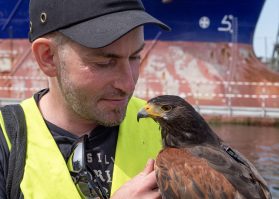Birds of prey have become a common sight at the Port of Gdańsk. They have a very important purpose – they scare off pigeons.
Stefan (our birds are named after Polish kings) patrols the port area, and his mere presence is enough to deter the flocks of pigeons that are lured to the terminal by the grain that is loaded and unloaded here. Such unwelcome guests bring trouble – nests, faeces and other contaminants. Originally, up to 4000 pigeons lived around the GBT terminal. Now there are significantly fewer of them, as they know that the area is dangerous with Stefan and his predatory friends standing guard like Cerberus. Every bird has its own caretaker. Stefan is looked after by Piotr Nadstawny, a forester by trade, for whom falconry is not only a job, but a great passion that he could talk for hours about.
This is not a circus
The falconers employed by Sokolnictwo.pl use only natural methods in working with their birds of prey.
‘We don’t tame our birds. This is not a circus. We teach them to fly in a way that makes sure that they return to us. In Polish, we call this układanie,’ says Piotr Nadstawny. ‘Taming involves rewarding and punishing, but there are no punishments in falconry. There are only rewards. If you punish a bird and then cast it off to hunt, you can bet it will never come back to you.’
Falconers specialise in deterring pigeons from approaching industrial infrastructure (factories, storage facilities, depots and office buildings), as well as pigeons and seagulls from settling down in port areas (shipyards and container terminals). They use the most environmentally friendly method to do so, capitalising on the genetic response encoded in pigeons – their fear of predators.
‘Pigeons can become a real nightmare. City pigeons breed very fast – up to 4 broods a year, 2 young in every brood. As a result, deterring them from coming to certain locations is simply a necessity. Falconry services ensure that planes can land safely, crops are protected, nature is preserved, and people can live healthy lives. We have been working with the Port of Gdańsk for several years now. We started out in the Gdańsk Shipyard, followed by the National Food Industry Group and the GBT grain terminal. The greatest challenge for Stefan and me is, of course, the GBT terminal. There are so many pigeons there. That is why the area is handled by three falconers, who, of course, work shifts,’ Nadstawny explains.
GBT President Rafał Różański admits that pigeon presence at the terminal is problematic, ‘But we have already begun to notice the results of the falconers’ work. There are already fewer pigeons. I’ve got to admit, this is the first time we’ve hired airborne staff.’ As you can see, wings can be an asset when working at a port.
A falconer’s job is to significantly reduce the presence of unwelcome avian guests in a location. Birds of prey reared using falconry methods conduct regular patrols of their assigned area, making local birds believe that they are on their hunting grounds. As a result, pigeons move to different areas rather quickly, areas where they do not need to risk facing off against predators, the fear of which is encoded into their genes.
The effectiveness of this method of bird deterrence is more than 95%. Up to 100% effectiveness is possible, but it requires that birds of prey maintain a constant presence in the area under their protection. In most cases where pigeons must be repelled, only a few patrols are conducted. Locations where this method is used include grain elevators, food processing plants, as well as orchards and fields. But there is one requirement – falcons must patrol the area regularly. If birds of prey are no longer present, pigeons will return.
What does a falconer do? Everything begins with a site inspection and the creation of a suitable plan of action. The number and frequency of patrols is determined, as well as the number of birds (and their species and gender), and any required permits are obtained. If the birds in need of repelling are sparrows, for example, it is best to use predators such as sparrowhawks or smaller male Harris’s hawks, while in the case of seagulls, it may be necessary to use female hawks (which are larger and stronger). Some birds are, of course, well suited to various tasks – such as male hawks (which include Stefan). Their job is to patrol the area. This lasts for several hours a day (several times a week). Stefan’s task is simply to be out there – to make his presence in the area known.
A bird of prey reacts primarily to visual stimuli. ‘The purpose of whistling is to make him look at me. There must always be a reward waiting on the gauntlet. If there is no reward, the bird will no longer want to work with you. Every bird of prey is different. If my Harris flies far away from me (the distance is usually up to a kilometre), I know he will come back. With falcons, you never know. Every bird is equipped with a telemetry tag, which weighs only 8 grams so that it doesn’t weigh the bird down. If a bird gets too far away, the tag helps us track it down,’ Nadstawny adds.
Can sounds be used to scare birds off? Falconers say they can, but not sounds made by birds of prey, but sounds made by certain species of birds (such as starlings) to warn the rest of the flock of incoming danger. Sound deterrence is useful for scaring off seagulls, crows and starlings, which are very social birds that make use of such warning sounds.
***
Many falconers are members of the ‘Gniazdo Sokolników’ Polish Falconry Club, and help cultivate this magnificent Polish tradition. Falconry is included in the UNESCO list of intangible human heritage, and is an important aspect of our culture. The list contains human activities specific to a particular area or cultural group, and Poland was already known as a global falconry powerhouse as early as the 16th and 17th centuries. In addition, Polish falconers participate in and manage the Peregrine Falcon Reintroduction Programme, which sees this beautiful bird slowly return to the Polish skies. So far, Sokolnictwo.pl falconers have released more than ten young falcons into the wild as a result.




